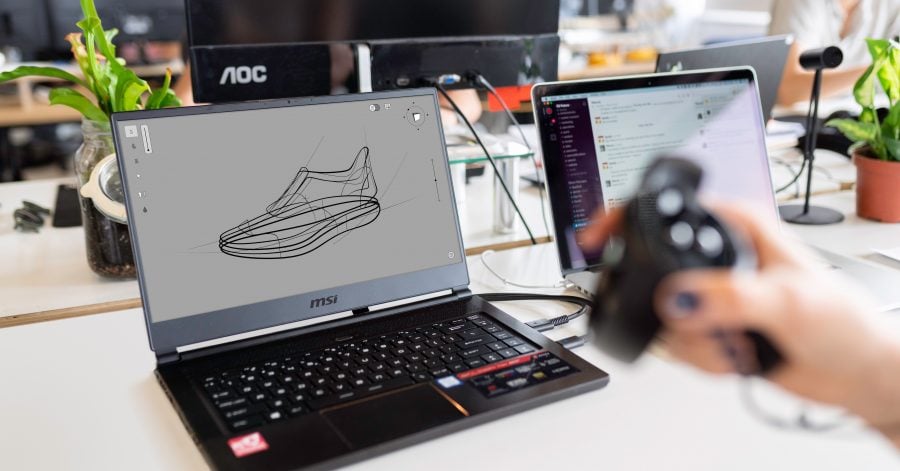Your sales presentation starts in 2 minutes. Enough time to look for the virtual business attire you bought for your work-from-home days. One click and you are all suited up. Too far-fetched? Well, tech companies are already working towards building the metaverse infrastructure, VR technology, immersive digital experiences, and NFT markets that could make virtual fashion a part of our lives.
First, virtual fashion includes a lot of things, from digital sampling, to 3D collections, virtual runway shows, and clothes you can purchase in digital formats (particularly crypto art and video games).
There are several potential buy-ins from fashion companies. For one, brands are betting that it will be a lucrative market segment. The rise of virtual-native fashion startups, as well as widespread adoption among mass-market and luxury brands alike are proof enough.
Then there is the question of whether digital fashion can improve the environmental impact of the fashion industry. The price of our clothes should include a complex heritage of emissions and waste produced across long supply chains. In 2019, it generated at least 10% of all GHG emissions; and if we continue at the same rate of apparel consumption, we will get to 102 million tons of textiles by 2030.
Consumers are increasingly aware of this new impact; with each demand for accountability, fashion brands are forced to pivot towards more responsible business models.
Can digital technologies and virtual fashion experiences help fashion brands in the pursuit of a better environmental footprint? The Recursive explored the answer with insights from fashion industry specialists and brand owners in Southern and Eastern Europe.
How virtual fashion could address overproduction and overconsumption
Fashion specialists believe virtual fashion has the potential to change how physical products are produced and showcased, including to address potential issues such as overproduction. One technology that can bring about transformation when adopted at scale is digital sampling.
“3D digital design and augmented reality will help brands reduce the waste generated in upstream operations. Working samples in technologies such as CLO gives brands the opportunity to showcase their new collections to buyers through digital samples. This method has already been adopted by brands such as Adidas, Emilio Pucci, and Theory. The use of 3D garment simulation decreases sample lead time from one month to one day; and it takes on no fabric waste compared to physical production,” Maria Sas says. She is the founder of Support.Supply, a community and sourcing web-platform for fashion professionals with focus on sustainability, started in Romania.
“With virtual fashion and our digital avatars, we can have made-to-order clothes. We can digitally try on the items we intend to purchase. By ordering items that we certainly know we like, we can reduce the production quantity, hence reducing the remains and textile waste,” adds Hana Zeqa, founder of Fight or Flight, a costume and fashion technology studio, based in Kosovo.
Elsewhere in the beauty sector, The Estée Lauder Companies follow the same principle with their virtual beauty store where you can try on products such as foundations and lipsticks.
Furthermore, virtual clothing startups such as DRESSX, which works like an e-commerce platform, argue that digital fashion can reduce overconsumption of physical clothes by serving the needs of audiences such as content creators.
It works like this: instead of buying new clothes that serve them in building fresh content for social media platforms, content creators can instead acquire virtual clothes, removing the burden placed on natural resources by supply chains and manufacturing. The environmental costs associated with shipping are also prevented (although e-mails also have associated emissions).
Overall, wearing a digital fashion item can have a 97% lower carbon footprint vs. the physical equivalent. And if we substitute 1% of physical clothing with virtual garments, the annual carbon footprint of the industry could be reduced by 35 million tons, says DRESSX.
Applied to a bigger market “it would be essential to see if digital fashion can satisfy the customer’s desire to have more. Unfortunately, we live in a time of overconsumption, where we have a lot more clothes than we need. Our wardrobes are full of clothes that we barely ever wear. Digital fashion could change this. A digital-only garment has a much lower impact on the environment and if it proves to satisfy the customer’s need to have new, exciting clothes all the time, this will be a great win for sustainability,” Denitsa Damyanova, co-founder of fashion brand blonde gone rogue, points out.
Finally, blockchain, which has already been used to improve supply chain traceability and sustainability, holds further opportunities for the fashion industry.
“Something that is super fresh and isn’t yet under the radar is the use of blockchain in connecting physical products with a digital replica that can be used online. Blockchain will play a major role in traceability once solutions will be found in terms of minimizing the environmental impact of it, too,” adds Maria Sas.
Clearly, fashion brands are interested
“Last December I attended the Circular Fashion Summit by Lablaco 2021, which was held at the Grand Palais Éphémère in the metaverse. Those who are dipping their toes in digital fashion are testing the landscape, as well as the different types of products and services they can offer to consumers. It’s still very early in the game and things will constantly change in terms of solution fit,” Maria Sas tells us.
With the metaverse proposed as the next version of the internet, many popular fashion brands are preparing for the next generations of fashion consumers: digital and metaverse natives.
It’s worth noting that, while the metaverse is one of the most talked about VR platforms given the holding group, there are many different marketplaces that offer alternative virtual universes.
“There are different platforms that offer unique high-stake items sold with crypto (NFTs) or standard currencies for lower valued products that can be used outside of Meta, for instance in Zoom/ Skype calls and for selfies to post on social media. DAOs (decentralized autonomous organizations) will influence the shift even more so through their competitive, free-world nature compared to the giants that have already monopolized the VR market,” Maria adds.
Big brands are taking on the challenge. H&M entered the game and followed all the rules. They partnered with DRESSX and influencer Maisie Williams to create a digital collection, and launched a social media campaign competition to create more hype in the community. High-end brands are not holding back either. Ralph Lauren opened a 24/7 digital store on gaming platform Roblox, featuring puffer jackets and skiwear for under $5.
With NFTs going mainstream, other retailers are collaborating with NFT collectors and artists. Adidas entered the space with the “Into the Metaverse” project, a collection of virtual wearables developed in partnership with NFT artists such as Bored Ape Yacht Club. Meanwhile, Nike acquired RTKFT, a startup of Bulgarian roots specializing in AR-enabled sneaker design and NFTs, with the intent to grow its pool of collectibles.
In Southeast Europe, too, brands are already preparing for a future that includes virtual fashion collection and digital technologies.
“We are working on making our digital designs as a brand that can be part of these digital fashion shops and apps, which will be like e-commerce or online stores. Hopefully, in the future we will have our own app as well,” Hana Zeqa says. At Fight or Flight, Hana is developing practical and sustainable fashion solutions by using smart textiles and electronics in garments.
Sustainability-focused brand blonde gone rogue, run by Bulgarian founders and suppliers, is also planning for the digital world in 2022. “We see digital fashion as a very exciting field that opens the door to endless possibilities,” Denitsa Damyanova tells us.
Virtual fashion has its own challenges
“I’ve been in conversation with digital brands who come to us because they need to audit their company and set their sustainability policies while changing their framework. Just because it’s virtual doesn’t make it environmentally friendly, as one Bitcoin transaction is the equivalent of hundreds of thousands of Visa card transactions,” Maria Sas explains.
The environmental impact of virtual fashion depends on the digital, blockchain, and cryptocurrency systems used to create and trade them, as well as maintaining the digital world in which we use them. In short, the issue is energy use. The main blockchain and cryptocurrency technologies on which NFTs are managed follow a consensus mechanism that requires a large computational power to verify records and transactions.
The good news is that alternative solutions do exist, such as proof-of-stake transaction models, roll-up technologies, or running the blockchain on renewable energy; and some of the more popular marketplaces have integrations with more energy-efficient blockchains, while the biggest current blockchain for NFTs, Ethereum, announced its intention to change to a proof-of-stake transaction model in 2022.
Meanwhile, companies such as Support.Supply, which aim to help brands transition to a circular production system, are taking into account digital brands and their specific needs in monitoring and reducing GHG emissions.
“Data-wise it can be easier to track the carbon footprint in blockchain through smart sensors technology compatible with IoT, which also could prove to save time, money and to efficiently extract relevant stats,” Maria Sas tells us.
. . .
In the end, it would be short-sighted to think digital clothes will solve all our issues with how we produce physical clothes, which we will still need. “It is important not to forget that unless we can go out in the real world wearing digital clothes, virtual fashion cannot substitute physical fashion. But it is up to us to take virtual fashion in a direction that will improve the current state of the fashion industry and its footprint on the environment,” Denitsa Damyanova concludes.








